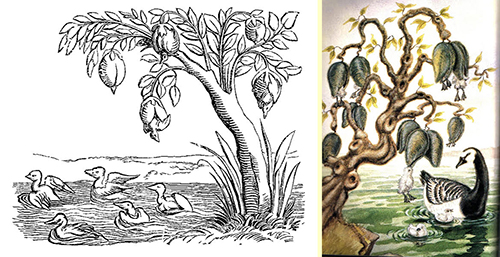 |
신화의 세계에 반인반수나 반신반인은 무진장 많다. 반신반수도 자주 눈에 띈다. 아주 드물게 반은 식물이고 반은 짐승인 존재도 있으니 반수반초(半獸半草), 반수반수(半獸半樹)다. 예를 들면 반양반초(半羊半草), 반압반수(半鴨半樹) 따위가 있다. 부록 보시라.
근데 현실의 세계에 반인반초(半人半草) 혹은 반인반수(半人半樹)라 할 만한 존재가 있다. 사람은 사람인데 식물 취급 받는 존재다. 주서식지, 주출몰지는 대한민국 서초동으로 알려져 있다. 최근 생태계에 변화가 생겨 그 반인반수는 조만간 서식지를 옮길 예정이란다.
 |
| 백 키로 남간 바라매 아니 뮐쌔, 곶 됴코 여름 하나니.... |
(부록)
반양반초(1)
중앙아시아. Boramez=vegetable lamb= lamb-plant. a legendary zoophyte of Central Asia, once believed to grow sheep as its fruit. It was believed the sheep were connected to the plant by an umbilical cord and grazed the land around the plant. When all accessible foliage was gone, both the plant and sheep died. a popular myth from the Middle Ages.
양들의 골육 ; 그 양은 뼈와 살이 있고 몸뚱아리 안에 피도 돈다. The vegetable lamb was believed to have blood, bones, and flesh like that of a normal lamb. It was connected to the earth by a stem, similar to an umbilical cord, that propped the lamb up above ground. The cord could flex downward, allowing the lamb to feed on the grass and plants surrounding it.
양들의 침묵 ; 풀이 죽으면 양도 죽는다. Once the plants within reach were eaten, the lamb died. It could be eaten, once dead.
양들의 쓸모 ; 피는 영양음료로 마시고, 울은 옷 만들어 입는다. Its blood supposedly tasted sweet like honey. Its wool was said to be used by the native people of its homeland to make head coverings and other articles of clothing.
 |
반양반초(2)
중국. In his work The Shui-yang or Watersheep and The Agnus Scythicus or Vegetable Lamb (1892), Gustav Schlegel points to Chinese legends of the "watersheep" as inspiration for the legend of the Vegetable Lamb of Tartary. Much like the vegetable lamb, the watersheep was believed to be both plant and animal and tales of its existence placed it near Persia.
 |
| 이백 키로 풀떼긴 바라매.... |
반압반수
일명 오리나무. barnacle geese. The Minorite Friar Odoric of Pordenone, upon recalling first hearing of the vegetable lamb, told of trees on the shore of the Irish Sea with gourd-like fruits that fell into the water and became birds called Bernacles. He is referring to the legendary plant-animal, the barnacle tree, which was believed to drop its ripened fruit into the sea near the Orkney Islands. The ripened fruit would then release "barnacle geese" that would live in the water, growing to mature geese. The alleged existence of this fellow plant-animal was accepted as an explanation for migrating geese from the North.
 |
관리자 freemediaf@gmail.com
<저작권자 © 자유언론실천재단, 무단 전재 및 재배포 금지>

